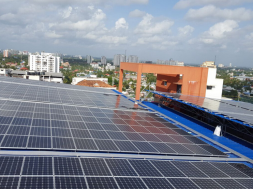
A new type of battery provides low-cost, long-term energy storage – EQ Mag Pro
Providing a new means for storing excess renewable energy.
A new battery design could allow for more affordable, long-term energy storage, a press statement from Imperial College London reveals.
The Imperial team of engineers and chemists developed a polysulfide-air redox flow battery (PSA RFB) with two membranes.
This dual membrane design provides a workaround for some of the issues with PSA RFB, meaning it could be used to store excess renewable energy for long periods of time.
The researchers, who published their findings in the journal Nature Communications, detailed how they searched for an alternative to the electrolyte vanadium, used in conventional redox flow batteries, which is typically expensive and primarily sourced from China or Russia.
To start with, they decided to use a liquid, polysulfide, as one electrolyte and a gas, air, as the other. However, their polysulfide-air batteries were limited by the fact that no membrane could enable the chemical reactions at the same time as preventing the liquid electrolyte from crossing over to the other part of the cell.
“If the polysulfide crosses over into the air side, then you lose material from one side, which reduces the reaction taking place there and inhibits the activity of the catalyst on the other,” said Imperial College’s Dr. Mengzheng Ouyang, who worked on the study. “This reduces the performance of the battery – so it was a problem we needed to solve.”
An alternative approach to long-term energy storage
The researchers developed an alternative approach, using two membranes to separate the polysulfide and the air, which contained a solution of sodium hydroxide in between both parts of the cell. All of the materials are cheap and widely available, and the team said there is still room for experimentation to look for even cheaper materials that would do the same job.
In their experiments, the Imperial team found that their polysulfide-air redox flow battery provided up to 5.8 milliwatts per centimeter squared, while the energy cost — the price of the storage material compared to the amount of energy stored — was calculated to be roughly $2.5 per kilowatt hour. The power cost — the rate of charge and discharge compared to the price of materials — was about $1,600 per kilowatt. Though this is too high for long-term storage, the researchers said they believed they would be able to greatly improve the power cost.
“To make this cost-effective for large-scale storage, a relatively modest improvement in performance would be required,” said Professor Nigel Brandon, who also worked on the project. This could be done “by changes to the catalyst to increase its activity or by further improvements in the membranes used.”
The Imperial team’s work meets a pressing need for new forms of energy storage as the world transitions into an era of renewable energy, following the IPCC’s latest report, which warns of dire consequences if the required steps aren’t taken to drastically reduce humanity’s global carbon footprint.


















